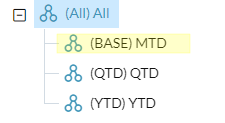Time Perspective is one of the required dimensions. It gives the flexibility to plan and report in different time periodicities, such as year-to-date, month-to-date, and quarter-to-date. Other periodicities can be added.
Time Perspective is a parent-child dimension.
Note: When creating a data view, calculated Time Perspective members (for example, YTD) are not supported when used in combination with a Time dimension alternate hierarchy. Time dimension alternate hierarchies will only properly aggregate data with the BASE Time Perspective member and will not work for any calculated Time Perspective member.
Time Perspective types
The members of the Time Perspective dimension can have the following types:
-
YTD
Year-to-date, the default.
-
HYTD
Half-year-to-date.
-
QTD
Quarter-to-date. This option only appears if the Time dimension includes a Quarter level type.
-
PTD
Period-to-date. This option appears for a non-calendar time structure (that is, one that uses periods instead of months).
-
MTD
Month-to-date.
-
HMTD
Half-month-to-date.
-
BWTD
Bi-weekly-to-date. (Meaning every two weeks; do not confuse with semi-weekly.)
-
WTD
Week-to-date.
-
LTD
Life-to-date. This option is not tied to a specific time level, but rather time from conception to current time member.
-
Calculated
If you choose this type, in Add Member you select one of the pre-defined member types plus its parameters.
The pre-defined types are as follows:
-
Average to Date
Reports the average from the start of the year to the current month.
-
Life to Date
Reports the sum of the life-to-date for the entire Time dimension.
-
Rolling Last N Periods
Reports the sum or average of the "N Periods" that you specify in Number of periods.
Note that Rolling Last N Periods ignores the Account dimension's Time conversion property and will only work for Account members whose Time conversion method is Sum.
-
This Time Perspective will ignore what has been set up in the Time Conversion for the account will only work for sum time conversion accounts
Note: In Member Properties, the Time perspective type attribute for all of these types is Calculated.
-
The standard members
When you create a model, Time Perspective always has the members Base and YTD.
Base is the default member and its periodicity depends on how you set up the Time dimension. That is, if you selected a non-calendar periodicity, Base would be Period-To-Date (PTD). A best practice is to rename the member to make it easier to understand. In the following example, the Name member property for Base has been changed to MTD:

Note: For this dimension, in Member Selector, you can only dynamically select the All member for inclusion in Selected Members.
Time Conversion property
The Account dimension's Time conversion property also affects how data is displayed in months, quarters, and years. Accounts that use the time conversion method Last always show the ending balance as time progresses. Revenue and Expense accounts with Time Conversion set to Sum act differently depending on the Time Perspective.
The data view below shows the Operating Expenses and Current Assets accounts:
Looking at June, note the following:
- MTD: Monthly Activity (also where the data is stored)
- QTD: Accumulates (Time conversion = Sum) until it resets at the beginning of the next quarter
- YTD: Accumulates (Time conversion = Sum) until it resets at the beginning of the following year
Time Perspective and Versions
Time Perspective can be used with Versions and is particularly useful for reporting.
The following example is from a Comparative Income Statement:

